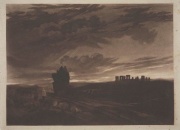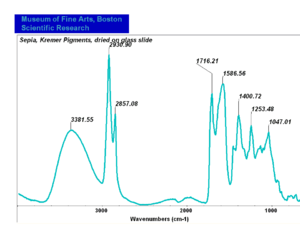Difference between revisions of "Sepia"
m (Text replace - "== Authority ==" to "== Sources Checked for Data in Record ==") |
|||
| Line 13: | Line 13: | ||
1: Warm Black; cuttlefish ink; sepiomelanin; Natural Brown 9; sépia (Fr., Port.) 3: cuttlefish bone; cuttlebone; sepiolite; | 1: Warm Black; cuttlefish ink; sepiomelanin; Natural Brown 9; sépia (Fr., Port.) 3: cuttlefish bone; cuttlebone; sepiolite; | ||
| − | [[[SliderGallery rightalign| | + | [[[SliderGallery rightalign|Sepia, Kremer Pigments.PNG~FTIR (MFA)]]] |
== Other Properties == | == Other Properties == | ||
Revision as of 09:06, 25 October 2019
Description
1) The dark brown-black liquid secreted by the cuttlefish, Sepia officinalis or other Cephalopoda. The ink sacs and fluid are removed from the squid and sun-dried; then the color is extracted with alkali and precipitated with acid. Sepia was used for inks since antiquity. It was first introduced as a watercolor pigment mixed with gum arabic about 1780 by Jacob Seydelmann in Dresden. Sepia is a natural organic acid that is fairly permanent, except in strong sunlight.
2) A dark, warm black color resembling the tone obtained from cuttlefish ink. Other pigment mixtures of burnt umber, Vandyke brown, and lampblack are also sold under the name sepia.
3) (not common) A powder composed of ground cuttlefish bones. Sepia powder, also called sepiolite, is composed of calcium carbonate and calcium phosphate. It is used as a polishing agent.
Synonyms and Related Terms
1: Warm Black; cuttlefish ink; sepiomelanin; Natural Brown 9; sépia (Fr., Port.) 3: cuttlefish bone; cuttlebone; sepiolite;
Other Properties
Soluble in ammonium hydroxide, alkalis. Insoluble in acids, water, ethanol. Decolorized by nitric acid and chlorine bleaches. Fishy odor. Fugitive in ultraviolet light.
Sources Checked for Data in Record
- R. J. Gettens, G.L. Stout, Painting Materials, A Short Encyclopaedia, Dover Publications, New York, 1966
- Helmut Schweppe, Schweppe color collection index and information book
- G.S.Brady, Materials Handbook, McGraw-Hill Book Co., New York, 1971 Comment: p. 609
- Reed Kay, The Painter's Guide To Studio Methods and Materials, Prentice-Hall, Inc., Englewood Cliffs, NJ, 1983
- Ralph Mayer, A Dictionary of Art Terms and Techniques, Harper and Row Publishers, New York, 1969 (also 1945 printing)
- Richard S. Lewis, Hawley's Condensed Chemical Dictionary, Van Nostrand Reinhold, New York, 10th ed., 1993
- Hermann Kuhn, Conservation and Restoration of Works of Art and Antiquities, Butterworths, London, 1986
- R.D. Harley, Artists' Pigments c. 1600-1835, Butterworth Scientific, London, 1982
- Matt Roberts, Don Etherington, Bookbinding and the Conservation of Books: a Dictionary of Descriptive Terminology, U.S. Government Printing Office, Washington DC, 1982
- Random House, Webster's Encyclopedic Unabridged Dictionary of the English Language, Grammercy Book, New York, 1997
- The Merck Index, Martha Windholz (ed.), Merck Research Labs, Rahway NJ, 10th edition, 1983 Comment: entry 8601
- The American Heritage Dictionary or Encarta, via Microsoft Bookshelf 98, Microsoft Corp., 1998
- Encyclopedia Britannica, http://www.britannica.com Comment: "sepia." Encyclopædia Britannica. 2005. Encyclopædia Britannica Premium Service 7 Apr. 2005 .
- The Dictionary of Art, Grove's Dictionaries Inc., New York, 1996 Comment: 'Pigment'


